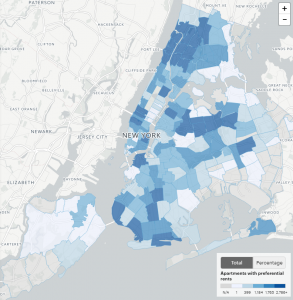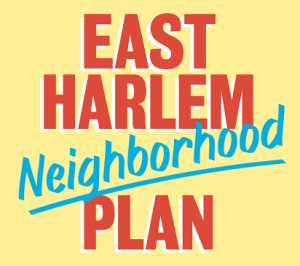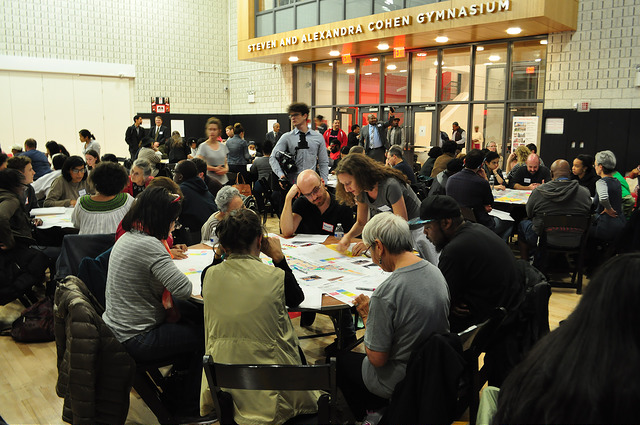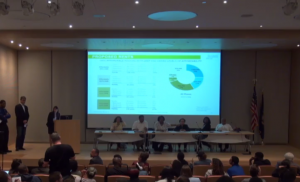East Harlem Stakeholders Demand No Vote at CPC Rezoning Hearing
Citing the City’s Divergence from the East Harlem Neighborhood Plan, Residents and Stakeholders Urge the City Planning Commission to Vote No on the East Harlem Rezoning
On Wednesday afternoon, at a packed venue, the City Planning Commission (CPC) held their public hearing on the proposed East Harlem rezoning. The CPC hearing comes after both Community Board 11 and Gale Brewer, the Manhattan Borough President, voted no on the proposed rezoning, and the bulk of the testimony heard from the East Harlem community on Wednesday strongly encouraged the CPC to do the same.
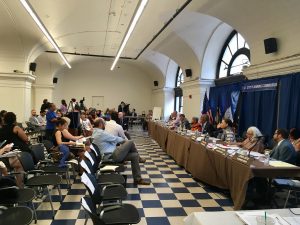 In East Harlem the process preceding The Department of City Planning (DCP)’s proposed rezoning started with the promise of a new, community-driven planning model, with the community unveiling its own neighborhood plan in advance of the City. This plan was started in 2015 when City Council Speaker Melissa Mark-Viverito brought together local stakeholders in the formation of a steering committee tasked with crafting a comprehensive plan identifying the neighborhood’s goals and needs. After months of community engagement, consensus-building, and dedicated work, the steering committee – led by the Speaker’s Office, Community Board, Community Voices Heard (CVH), and Borough President Brewer – unveiled their vision with the East Harlem Neighborhood Plan (EHNP), including a broad set of demands across 232 recommendations. While many participants have stressed that the final product still needs improvement, the idea was that DCP would work with the community to improve the East Harlem Neighborhood Plan and make it a reality. Instead, the feeling from the community, Community Board, and Borough President’s Office is that the EHNP has been largely ignored.
In East Harlem the process preceding The Department of City Planning (DCP)’s proposed rezoning started with the promise of a new, community-driven planning model, with the community unveiling its own neighborhood plan in advance of the City. This plan was started in 2015 when City Council Speaker Melissa Mark-Viverito brought together local stakeholders in the formation of a steering committee tasked with crafting a comprehensive plan identifying the neighborhood’s goals and needs. After months of community engagement, consensus-building, and dedicated work, the steering committee – led by the Speaker’s Office, Community Board, Community Voices Heard (CVH), and Borough President Brewer – unveiled their vision with the East Harlem Neighborhood Plan (EHNP), including a broad set of demands across 232 recommendations. While many participants have stressed that the final product still needs improvement, the idea was that DCP would work with the community to improve the East Harlem Neighborhood Plan and make it a reality. Instead, the feeling from the community, Community Board, and Borough President’s Office is that the EHNP has been largely ignored.
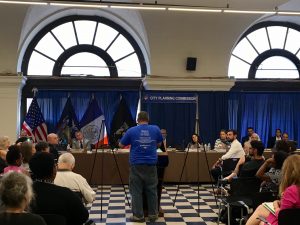 This is why the Community Board voted no to the rezoning, with recommendations, and why Gale Brewer voted a firmer no, with no recommendations. This is why CVH members and other East Harlem residents came out in force to demand the CPC vote no. As one CVH member put it, “This is about the life and death of East Harlem. I don’t know how DCP could come up with a plan totally opposite of what the community proposed.” Speakers pointed out that DCP’s plan allows much higher density than the EHNP and does not include adequate anti-displacement protections for existing tenants, appropriate investments for NYCHA properties that are in dire need, and the creation of truly affordable housing that meets the income requirements of current East Harlem residents – all priorities clearly laid out in the EHNP.
This is why the Community Board voted no to the rezoning, with recommendations, and why Gale Brewer voted a firmer no, with no recommendations. This is why CVH members and other East Harlem residents came out in force to demand the CPC vote no. As one CVH member put it, “This is about the life and death of East Harlem. I don’t know how DCP could come up with a plan totally opposite of what the community proposed.” Speakers pointed out that DCP’s plan allows much higher density than the EHNP and does not include adequate anti-displacement protections for existing tenants, appropriate investments for NYCHA properties that are in dire need, and the creation of truly affordable housing that meets the income requirements of current East Harlem residents – all priorities clearly laid out in the EHNP.
The de Blasio administration has claimed that it’s interested in a more comprehensive approach to neighborhood rezonings – one that meaningfully involves communities in the planning process to better ensure the priorities of local residents are met. If they’re serious about this, then East Harlem is a chance to get it right. The CPC should heed the call of the community and its representatives and vote no. The City still has time to step back and ensure that the priorities laid out by the community – through much time and effort – are met. Whether this happens through a rezoning, or other City actions, is less important than respecting the community’s vision and working with them to help make it a reality.
Christopher Walters, ANHD’s Rezoning Technical Assistance Coordinator
 ANHD 2016 Building the Community Development Movement
ANHD 2016 Building the Community Development Movement


